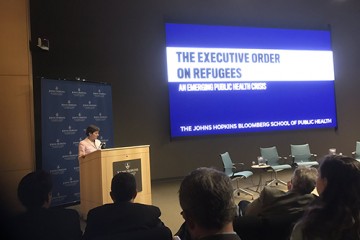It did not take long for Paul Spiegel and Len Rubenstein to react after President Donald Trump first tried to institute a travel ban on people from seven Muslim countries. Shortly after that executive order was signed in late January, Spiegel, director of the Center for Humanitarian Health at the Bloomberg School of Public Health, and Rubenstein, a faculty member in the school's Center for Public Health and Human Rights, responded with a comment in The Lancet. They called for the ban's repeal, emphasizing the harm it could do to refugees who had fled war or persecution.
In particular, they focused on the plight of the millions of Syrians chased from their country by a brutal and chaotic civil war now entering its seventh year. The executive order would not only have blocked for four months the resettlement of all refugees hoping to come to America; it would have suspended indefinitely the entry of any Syrians, describing that influx as "detrimental to the interests of the United States."
Spiegel and Rubenstein pointed out that most of the refugees already chosen for resettlement in America were women and children, and that the vetting process involves multiple layers of security checks by numerous government agencies, lasting an average of 18 to 24 months. They added that since 1980, when the U.S. Refugee Act was passed, no refugee has been implicated in a fatal terrorist attack in the United States.
A federal appeals court blocked the original travel ban, prompting the administration to respond with a less restrictive version that no longer singled out Syrian refugees for an indefinite ban, instead including them with other refugees facing a 120-day freeze on resettlement. But the new executive order still cut by half the number of refugees that would be permitted into the United States in the 2017 fiscal year—from the total of 110,000 pledged by Barack Obama to only 50,000.
Spiegel and Rubenstein responded with another letter to The Lancet: "The new order suspending and then shrinking the refugee resettlement program does not bring any security gains and imposes tremendous mental and physical harm on people who have suffered more than most of us can even imagine.
"Let them in."

Spiegel has seen firsthand how dire refugees' lives can be. Before coming to Johns Hopkins last year, he had been a high-ranking official in the office of the United Nations High Commissioner for Refugees. He visited refugee camps in Africa, Jordan, and Lebanon, and witnessed conditions rife with public health hazards—limited access to clean water, poor sanitation, severe overcrowding. The spread of disease was a constant risk.
The majority of global refugees do not live in camps, but they're often crammed into urban apartments or settle in remote rural areas where conditions aren't much better. To make matters worse, this precarious existence now lasts longer than ever before. In the past, someone was considered long-term if he or she was a refugee for three years. Now, people live as refugees, on average, for at least a decade, Spiegel notes. That's how long it typically takes for them to be able to either return to their homeland, get permission to stay in the country to which they escaped, or be accepted into a third country, such as the United States. "Less than 1 percent gets resettled in a third country," he says. "Most people want to go home. Home is home."
No one can begin to guess when Syrians might safely go home. Their situation is not the only refugee crisis in the world, but it has been the most noticed and reported by the Western press. Since catastrophic civil war broke out in 2011 when President Bashar al-Assad violently cracked down on protesters inspired by the Arab Spring movement, more than 400,000 Syrians have been killed, and another 11.5 million—equal to the combined populations of New York and Chicago—have been displaced from their homes. That's more than half the population. An estimated 5 million have left the country, with the vast majority moving to Turkey (almost 3 million), Lebanon (about a million), and Jordan (more than 650,000). Beginning in late summer 2012, uprooted Syrians began pursuing another escape route—across the Mediterranean to Greece, Italy, and Europe beyond. That journey added more terrible risk to lives already traumatized by the loss of homes and families—a treacherous water crossing on crowded and often flimsy boats, some no more than inflatable rafts. Last year, almost 4,000 refugees died trying to cross the Mediterranean.
Still, more than a million Syrians have made it to Western Europe and requested asylum. While that's provided them with at least a temporary safe haven, it also has fed a perception that the continent is being inundated by outsiders. And that has fed the rhetoric of populist, nationalist politicians in the United States and in Europe. They have seized the opportunity to portray Syrian refugees as just the latest wave in a flood of migrants to the West—a trend that has been stirring resentment and anxiety for years, particularly among those convinced the new-comers are stealing their jobs. Add the fact that the Islamic State, ISIS, has been a combatant in the Syrian civil war, and it has become all too easy to associate refugees with terrorism.
For example, during his unsuccessful campaign to become prime minister of the Netherlands, Dutch far-right leader Geert Wilders described Syrian refugees as an "Islamic invasion" and said the men among them were waging "sexual jihad." Nigel Farage, who led the Brexit campaign to get England out of the European Union last year, complained that parts of Great Britain were "like a foreign land" and that ISIS was using refugees to "put jihadists on European soil." French far-right presidential candidate Marine Le Pen delivered a similar message.
For his part, Trump has focused more on what he termed the "dangerous criminals" who illegally enter the United States from Mexico and Central America. But he also has characterized the refugee crisis as "a great Trojan horse" that would make it easier for terrorists to get into America. "What is different now is the linkage that's made between refugees—and immigrants to some extent—and terrorism," Rubenstein says. "That's become the mantra. In most cases in the past, national security was not invoked when people talked about refugees. But there's been a shift in values, and that shift is important because it explains the intensity of the opposition."
Video credit: Bloomberg School of Public Health
Spiegel and Rubinstein respond as the researchers they are, with data and facts and meaningful distinctions. One of those distinctions is between refugees and migrants. Nativist politicians purposely conflate the two, but in fact the terms refer to people with a distinctly different legal status. A refugee is, by definition, someone able to prove that he or she fled their native country to escape war or persecution. By international law, refugees cannot be sent back to countries where their lives would be in danger. Refugees considered for entry to the United States are vetted by several government agencies, including the Department of Homeland Security, the FBI, and the State Department, before they're permitted into the country. Furthermore, all refugees allowed into the States are expected to find employment and required to apply for a green card within a year of their arrival.
Migrants, by contrast, are people moving for reasons other than war or persecution. They may be fleeing poverty, or simply seeking better economic opportunities elsewhere. They might be migrating to join family members who emigrated before them. In recent years, more migrants have been forced to relocate because of the impact of climate change. There's already an ongoing discussion about whether people forced off their land by persistent flooding, drought, etc., should be treated as refugees because though they're moving for economic reasons, it's by necessity, not choice. "Forced migration as a result of climate change is going to be huge," Spiegel says. "Some people may have no choice but to move. The economies of some countries will change." A change in the status of migrants to refugees is significant because migrants are not granted asylum and can be deported. Once refugees are granted asylum, they can't legally be sent back.
By tying migrants and refugees together, populists have been able to conjure the double threat of terrorism and job insecurity. Courtland Robinson, an assistant professor in the Center for Humanitarian Health and a researcher on refugee issues and policy for almost 40 years, says he has been discouraged to see that happen in the United States. "I really thought we were moving past that as a country, that we were maturing and becoming more pluralistic in our thinking about what it means to be American," he says. "But if you are challenged economically, you can feel that the benefits of being American are beginning to pass you by, in favor of other people.
"That's where people can think, 'If there were fewer of those other people, my life would improve.' And if a person starts demonizing them and raising these visceral fears of the other, people say, 'Hey, that's my feeling, too.'"
Spiegel notes that such distortions and manipulation of facts to raise anxiety about migrants and refugees have become more common. "Our goal [as researchers] has been to make sure that people have proper information to make a decision, or come to a conclusion, both policymakers and the public. But it's particularly frustrating now," he says. Spiegel noted that while there's nothing new about people interpreting facts differently, "what's happening is that it seems like the 'facts' are changing, rather than just an interpretation of the facts."
He can cite any number of studies that have drawn conclusions about the impact of migrants and refugees that are much different from what's been widely claimed by immigration opponents. For instance, a report published last year by the National Academies of Sciences, Engineering, and Medicine found that, contrary to the assertion that immigrants hurt native-born workers and are a financial drain on the host country, they have a positive effect on the nation's economy. When measured over a period of 10 years or more, the impact of immigration on the wages of native-born workers is "very small" and generally limited to natives who haven't finished high school. While first-generation immigrants are more costly to government, mainly at state and local levels, than the native population (in large part owing to the costs of educating their children), as adults the children of immigrants are among the strongest economic and fiscal contributors in the U.S. population, paying more in taxes than either their parents or the rest of the native-born population. Over the long term, the impact of immigrants on government budgets is generally positive at the federal level, though it remains negative at the state and local levels; these generalizations vary tremendously across states.
Another study last year, by the National Foundation for American Policy, determined that 44 out of 87 privately held companies valued at more than $1 billion had at least one immigrant founder. It also estimated that these companies created an average of 760 jobs each.
As for migrants and refugees increasing the risk of terrorism, recent analysis by the libertarian Cato Institute countered that notion. It estimated that between 1975 and 2015—even taking 9/11 into account—the chance of an American perishing in a terrorist attack committed by a foreigner on U.S. soil was 1 in 3.6 million per year. If that foreigner is a refugee, the risk goes down to 1 in 3.64 billion per year. If he or she is an illegal immigrant, 1 in 10.9 billion per year. The chance of being murdered by a tourist on a B visa, the most common tourist visa, is 1 in 3.9 million per year.
Another negative insinuation is that a high percentage of illegal immigrants have committed serious crimes. But the nonpartisan Migration Policy Institute estimates that of the roughly 11 million immigrants now in the United States illegally, about 300,000, or less than 3 percent, have felony convictions. "There has been a lot of political grandstanding," says Randy Capps, the institute's director of research for U.S. programs. "What is worrisome is the explicit effort in some of these [presidential] executive orders to spin the data. They'll report something like the cost of refugee resettlement. Not the costs and benefits, just the costs. So, there are elements of a strategy of partial information release. It's telling just one side of the story."

Widespread data distortion or misrepresentation is a troubling development for Spiegel and others working to provide a clear-eyed perspective on what's become the world's greatest refugee crisis since World War II. Spiegel notes that human migration is now more complex and its impact more far-reaching than ever. There are, according to the United Nations, currently 21 million refugees on the planet. More than 41 million people remain in their home countries but have been internally displaced. "One of the issues we're struggling with is how do you deal with all this movement, in terms of basic services, education, and health care," Spiegel says.
Not long after Spiegel arrived at Johns Hopkins, what had been the Bloomberg School's Center for Refugee and Disaster Response became the Center for Humanitarian Health. Spiegel, who directed the change, saw refugees as only a segment of the population he thought the center should serve. He also viewed its mission as not so much to respond to disasters but to do research and provide training that enables health care professionals to address the needs of people who have left their homelands.
Spiegel says one of the big challenges is integrating migrants and refugees into the health care systems of their new countries. More study is needed on how best to maintain some continuity of their health care, he says. "Health is at the core of so much of this. If your health is not good, you're not going to be able to work and support your family."
But a reasoned approach based on research and field experience can be drowned out by the chorus of populist rhetoric, a trend that can make people like Spiegel and Robinson feel as if they're swimming upstream. Spiegel says he's worried about the potential repercussions of the United States slashing its foreign aid budget. "First, it's going to affect hundreds of millions of people, and that's obviously a problem," he says. "But you have to be careful not to define foreign aid as just wanting to help people. Aid is an instrument of the U.S. government to help its foreign policy. By cutting aid, it's going to hurt American diplomacy. And, if you have a lot of disgruntled people in Jordan, Syria, or Kenya, they're going to suffer more, and they're going to move, causing even more migration. When people become hopeless, bad things can happen."
Spiegel remains committed not just to research that can benefit migrants and refugees but also to compiling and disseminating accurate data on their plight and impact. Yet he concedes that he's still wrestling with how to engage effectively with those who see them as a menace. "Now that facts are being deliberately misused, it's even more important that we get the information out there so that people can make their own decisions. But probably not through the mainstream media. It's getting into those media and social media sites where people have quite different opinions. That's what we have to target. But it's not easy."
Robinson appreciates the difficulty of presenting facts to people disinclined to believe them. Maybe, he suggests, focusing on human stories rather than data is a better way to go. He shares a story to make his point. "When I was working with the U.S. Committee for Refugees and Immigrants, we helped support a survey. It found that if you shared a story about a particular family fleeing their country and you asked people how they would feel about this family moving next door, the majority of people tended to say positive things. They'd even talk about how they might try to help them adjust. But if you asked them more generically about how they felt about refugees, the attitudes shifted. It became more of a 50-50 split. People had more questions. They wanted to know where the refugees were from, and how many you were talking about. More people wanted to put some conditions on the refugees. You got people saying, 'Keep them out until we know everything about them.' Well, you never know everything about anybody."
He adds that an undercurrent of xenophobia has flowed through American culture for a long time. "The questions of who belongs and who doesn't, and who gets to decide, have, throughout our history, been fraught with pain and controversy. There have been people who have suffered egregiously or whose lives have been lost because a more privileged group or race said they didn't belong. Or they belonged, but only as a second-class citizen. Or they belonged, but not on certain land. We should not forget that these matters have been contested from the very beginning of our country."

Robinson finds reason to be encouraged by his experience in dealing with an earlier daunting refugee crisis—the flight of Southeast Asians after Communist takeovers in South Vietnam, Laos, and Cambodia in the 1970s. Those fleeing became known as the "boat people," and many died on ill-fated trips aboard barely seaworthy boats packed with refugees. Through his work at the Indochinese Refugee Action Center, Robinson—who later wrote a book on the crisis, Terms of Refuge: The Indochinese Exodus and the International Response (Zed Books, 1999)—saw how international cooperation among 70 nations over two decades enabled almost 3 million Indochinese to be resettled in other countries, including more than 750,000 Vietnamese who came to the United States.
He remembers that a lot of questions were raised then by critics, in the press, and during congressional hearings. People debated how many Indochinese should be admitted. Some worried about the risk of allowing people who may have been former members of the Viet Cong or Khmer Rouge into the country. Others complained that some nations weren't doing their fair share. Ultimately, though, the United States played a leading role in helping to shape international agreements that eased the crisis.
"It worked," Robinson says. "It took almost 20 years, from 1979 to 1997, but it worked." So, even in a time when messages of intolerance and suspicion get plenty of play, Robinson remains optimistic. "History makes me hopeful," he says. "We've seen anti-immigrant sentiment before, and we've seen terrible eruptions of ethnic violence. But we've also seen throughout history a lot of examples of cooperation that have, by and large, solved many of the problems.
"History tells me to take the long view and remind people what has worked, and why, as a nation, we are enriched by immigrants and refugees. Withdrawing can, in the end, make us poorer and less safe.
"The benefits outweigh the risks. Take the risks. It's good for the country."
Posted in Politics+Society
Tagged immigration, refugee crisis, center for humanitarian health, world in flux












